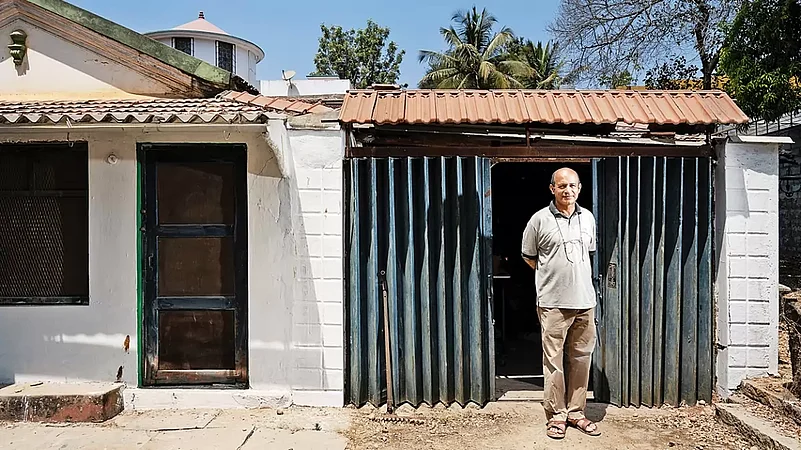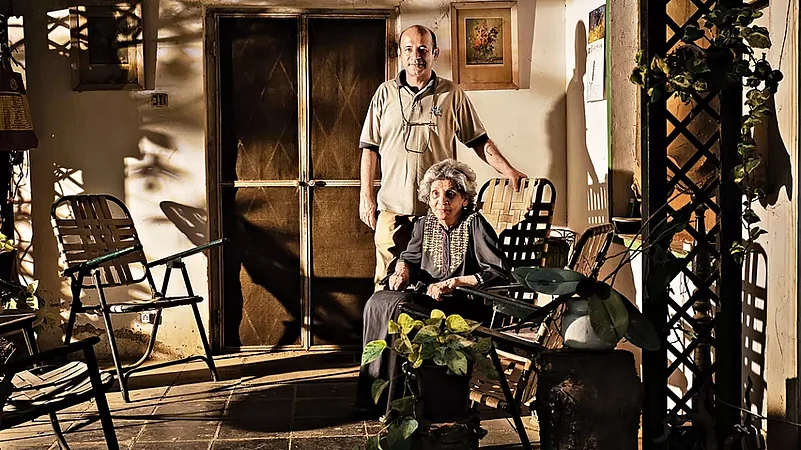A big blue board hanging from a white skywalk reads “Whitefield”. The road ahead provides a unique kaleidoscope of all kinds of obstacles— the Whitefield-KR Puram metro station that is under construction, road widening projects that are yet to be completed and hundreds of vehicles stranded amid traffic. The skyline is dotted with the Bengaluru’s famous IT hubs. Amid all this hustle and bustle, there is a secluded lane. Inside the lane, you can spot a quaint colonial house—‘Perfect Peace’—surrounded by trees and a deafening silence.
This is where Paul D’Souza stays with his mother Meryln D’Souza, an Anglo-Indian. The house was one of the first to be built in the Inner Circle way back in the 1900s when Whitefield—named after David Emmanuel Starkenburgh White, the founder and first President of the Anglo-Indian Association of Madras—was established as an Anglo-Indian village. The 3,900-acre land was given by King Chamraja Wodeyar IX, the Maharaja of Mysore, to the Eurasian and Anglo-Indian Association in 1882 for the establishment of an agricultural settlement.
Advertisement
D’Souza has been staying in ‘Perfect Peace’ with his mother since 1986 after they bought the house from its previous owners, the Rourkes, who were one of the original settlers. “Can you believe it? We bought this house for just Rs 3 lakh! It is my dream home,” his mother says, exuding warmth to every stranger who walks by to adore the heritage of the place.
The number of Anglo-Indians has been dwindling with many next-generation Anglo-Indians deciding to move to Australia, Canada and Germany in the 1960s and 70s. The British government had given a choice to this generation to settle in the United Kingdom. But D’Souza—who has two brothers living away from India—says his heart belongs to Whitefield.
Advertisement
“The kind of creative person I am, I cannot imagine being anywhere else other than home. We have been born and brought up here so I chose to stay here,” he says as he shows his collection of antique tools he uses to make watches. Nestled inside his beautiful home is his self-made workshop where he makes watches and, more interestingly, geometry material for visually-impaired children.
“I can work in the garden, out in the open, amid nature. Why would I want to leave?” he says when asked if he has given a thought to setting up an independent factory. “I am a different kind of tech person,” he says, chuckling.
D’Souza’s mother explains how they housed the former owners as guests until they breathed their last. “We did not want to dislodge them from their homes like most families in the community have been dislodged from theirs. We would give them their last cup of tea every night, and then their last cup of tea ever,” she says. We can still feel their spirits here, she adds, lifting her arms in the air. The same arms had held the bodies of Rourkes when they died.
A Turning Point
While D’Souza and his family managed to carve out ‘Perfect Peace’ for them, not every family from the community was able to do so. The establishment of the International Technological Park (ITPL) in Bengaluru in the late 1990s changed things in the vicinity.
Advertisement

What was once established as a quaint settlement for Eurasians and Anglo-Indians of Bangalore in the 1880s is now a tech hub housed with IT firms and high-rise buildings. According to reports, currently more than four lakh ‘techies’ work in various multinational companies located in the Whitefield region. Since 2013, more than 28,500 new residential units have been added here.
The area which was once limited to just a main road connecting the Inner Circle of Whitefield to the Outer Circle is now occupied with gated communities, a mall, well-known eateries and hospitals.
A common concern shared by all the residents is that such unbridled expansion has been disasterous. “The infrastructure has not kept pace with such level of expansion. The land of the original owners of these houses was compromised for building the tech park which was built in the middle of nowhere,” says D’Souza.
Advertisement
With the next generation deciding to fly abroad, many of their properties were left vacant back home. “There was land grabbing on a massive scale. Old house ownership documents in the Panchayat House were burnt or were misplaced in order to make way for new cooked-up documents to make use of the land,” he adds.
This systematic erasure of history preserved by older residents of Whitefield triggered the beginning of the downfall.
Advertisement
Houses with saddleback roofs, arched windows and spacious gardens were given up for huge high-rise apartment complexes with glass windows and multiple facilities. D’Souza recalls how many brokers landed upon the pavement of his house to place a seemingly valuable offer of turning their land into an apartment.
Sean Lawrence recalls the same story. He lives with his mother Judy Lawrence and grandmother Shirley Davis in ‘Little Gem’ which was built in 1915. He says being together with family is equal to being home. “My grandmother was presented with the opportunity of going abroad but she did not take it because she wanted to stay back to take care of her parents. Similarly, my mother wanted to stay for her family. That is why I am here too,” he says.
Advertisement
He points to the dark brown desk behind the sofa, the table in the dining hall and another stray cupboard in the living room. “I have a connection with all this. My children are the fifth-generation to be here. They love being here and are already eyeing their favourite pieces in the house,” he says.
The colonial house with a high-tiled roof was originally said to have been a police station in the 1930s and 40s. It is perhaps the first sign of old-style architecture that one would glance upon when arriving at the area. It was also the first place in Whitefield to hoist the Indian flag post independence, Lawrence says. He has still preserved the flag post.
Advertisement
In 1994, the old wall lining the house, which is now on a bustling main road, was about to be demolished as part of the government’s efforts to clear encroachments. A fight in the court helped stay the order on the same. Then, in 2007, the government went on a drive to remove illegal hoardings. That is when parts of the wall were knocked off. “We went to the BBMP (Bruhat Bengaluru Mahanagara Palike) and they said it was a mistake. They told us we could rebuild it,” Lawrence says.
But the space continues to be a bone of contention between the family’s fight to preserve it and the government’s fight to grab it, which is the story of the few other prominent landmarks that are left of the settlement.
Advertisement
The rampant commercialisation in the area has put many historic buildings like the Memorial Church and Whitefield Club in danger of being lost forever.
The Club which was intended as a social gathering place for the Anglo-Indian residents of Whitefield is one of the last few prominent landmarks here. People used to gather to discuss current affairs, participate in group meetings and celebrate festivities, especially during Christmas. “Not many people come here anymore. There are so many apartment complexes and gated communities that have their own clubs so one does not see a lot of people here,” says a resident whose ancestors were one of the first settlers of Whitefield in the 1880s.
Advertisement
But the same residents stood against a proposed road widening project in 2005-07. Around 216 roads were approved to be widened, including the Whitefield main road. At that time, the Club and the Memorial Church property—the original Protestant Church—were two such original buildings that would have been in danger.
Over the years, the area has witnessed human chains, mobilisations and other forms of protest by citizens against such road-widening projects.
The residents recall that one day in 2016, at 6:00 am, the BBMP arrived with the police and bulldozers and demolished the wall of the Club, without any prior notice. “No one was here to protect the place. They haven’t given us compensation for it even now. We are still paying property tax for the area that the government owns,” the resident says, standing on the barren piece of land.
Advertisement
Today, while ‘Perfect Peace’ lies in a calm street, ‘Little Gem’ is surrounded by a gated community filled with three-BHK houses. Lawrence recalls how brokers had approached him asking him to hand over parts of his house to them. “But this is our house. The minute we step out of the gate, it doesn’t feel like that anymore,” he says.
As the residents try to balance the present by preserving the past and adjusting to the future, they say that the change has helped them in some ways.
“We now have a medical store, groceries store and a hospital nearby,” Lawrence’s mother says. “In those days, we would have to go to town to Bangalore to get all of this,” she recalls.
Advertisement
The town in those days was the same city that Whitefield was eventually absorbed into. She corrects herself immediately. “We are so used to calling it a town.”
While modern facilities make life more convenient, we all miss the old world charm and the life we had in Whitefield, the descendants of the original settlers say. “This new Whitefield has no soul. It is only made of glass and steel,” D’Souza says.
(This appeared in the print edition as "Preserving the Present")





















